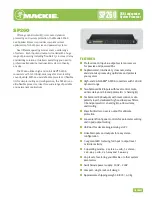
48
ID-E270-011GB
Since wireless radio detectors create a line branch, automatic configuration and configuration with
verification is possible only in the case of the adapter installation in the detection line. If the adapter
is installed in a radial line, its configuration should be carried our manually.
6.3 DESIGN GUIDELINES
Due to installation operation reliability, a loop-shaped detection line routing system should be
applied. Radial lines should be used only exceptionally (e.g. in case a small number of detectors must
be installed in a long distance).
When designing a detection line, each addressable element must be assigned with its own address
(element number), under which it shall be identified by the control panel. In order to assure the
installation project clarity and service facilitation, it is recommended that the consecutively installed
elements possess consecutively increasing addresses – best if assigned in accordance with the
control panel number allocation algorithm, which is utilized during automatic configuration.
The ADC-4001M adapters are fitted with an illuminating diode that signals a side line detector
triggering. Therefore, such adapter can be installed in front of premises, instead of an actuation
indicator. Regardless of this, it is possible to attach the WZ-31 actuation indicators to the ADC-4001M
side line detectors as well as to 4046 model range detectors.
It is recommended to use screened wires in the POLON 4000 system.
In the installation design process it is important to meet all requirements contained in technical
specifications; pay special attention should be paid to the detection line capacity. The detection line
appropriate resistance should be provided as well as resistance between neighbouring short circuit
isolators.
7 ALARMING SYSTEM/STRUCTURE AND EXECUTIVE LINE ELEMENT DECLARATION
The POLON 4900 control panel alarming structure as well as other programmable parameters must
be defined during the installation designing stage. For this purpose, the designer's tables must be
correctly filled in, taking into account the conditions existing in the protected premises. These tables
are an integral part of a design and must be available to the commissioning and service personnel.
The alarming structure is programmed as follows:
-
addressable elements declaration, assignments to zones, operation modes and groups;
-
alarming variants and user's messages declaration;
-
general alarming parameters programming (T1, T2, T3 times)
-
programming of actuation variants and monitoring of all monitoring and controlling elements
outputs and inputs.
7.1 DETECTION ZONE
Addressable elements must be programme grouped in detection zones; it is possible to create max.
1024 zones in the control panel. According to the standard, max. 32 line elements may be assigned
to one zone. Zones to which no element has been assigned are referred to as empty or inactive. The
zones are created to describe a given detection area with a given set of line elements in a manner
making it possible to identify the installation location. Moreover, a zone allows a given alarming
variant programming in order to eliminate false alarms in facilities where the risk of accidental
actuation of fire warning devices is high.
An area of one zone may be divided into two groups of fire warning devices, defined as A and B. Each
fire warning device must be assigned to one of these groups during the programming process. The
groups of fire protection elements (A/B) are created in order to program coincidental variants of
zone alarming in order to eliminate false alarms as much as it is possible.
















































